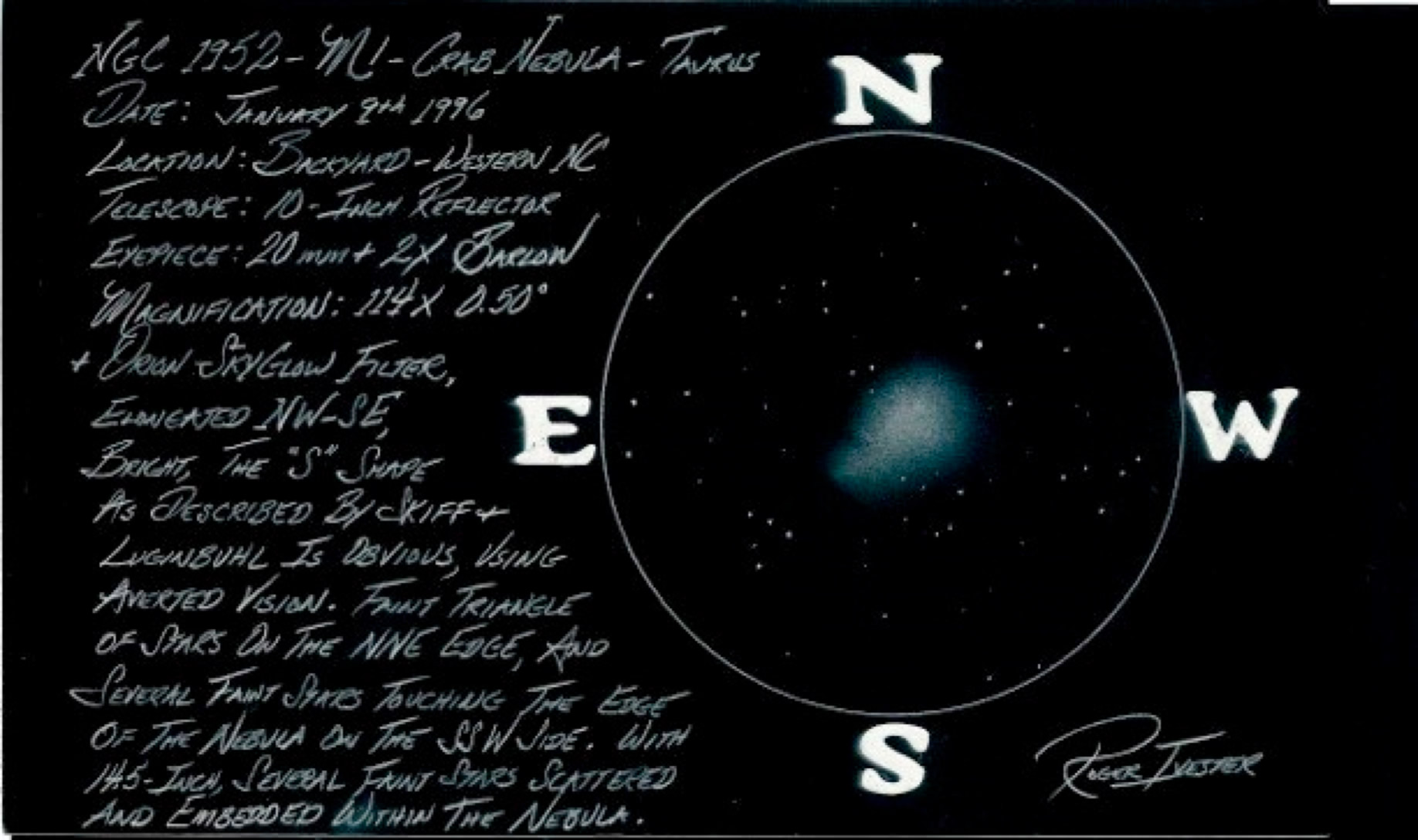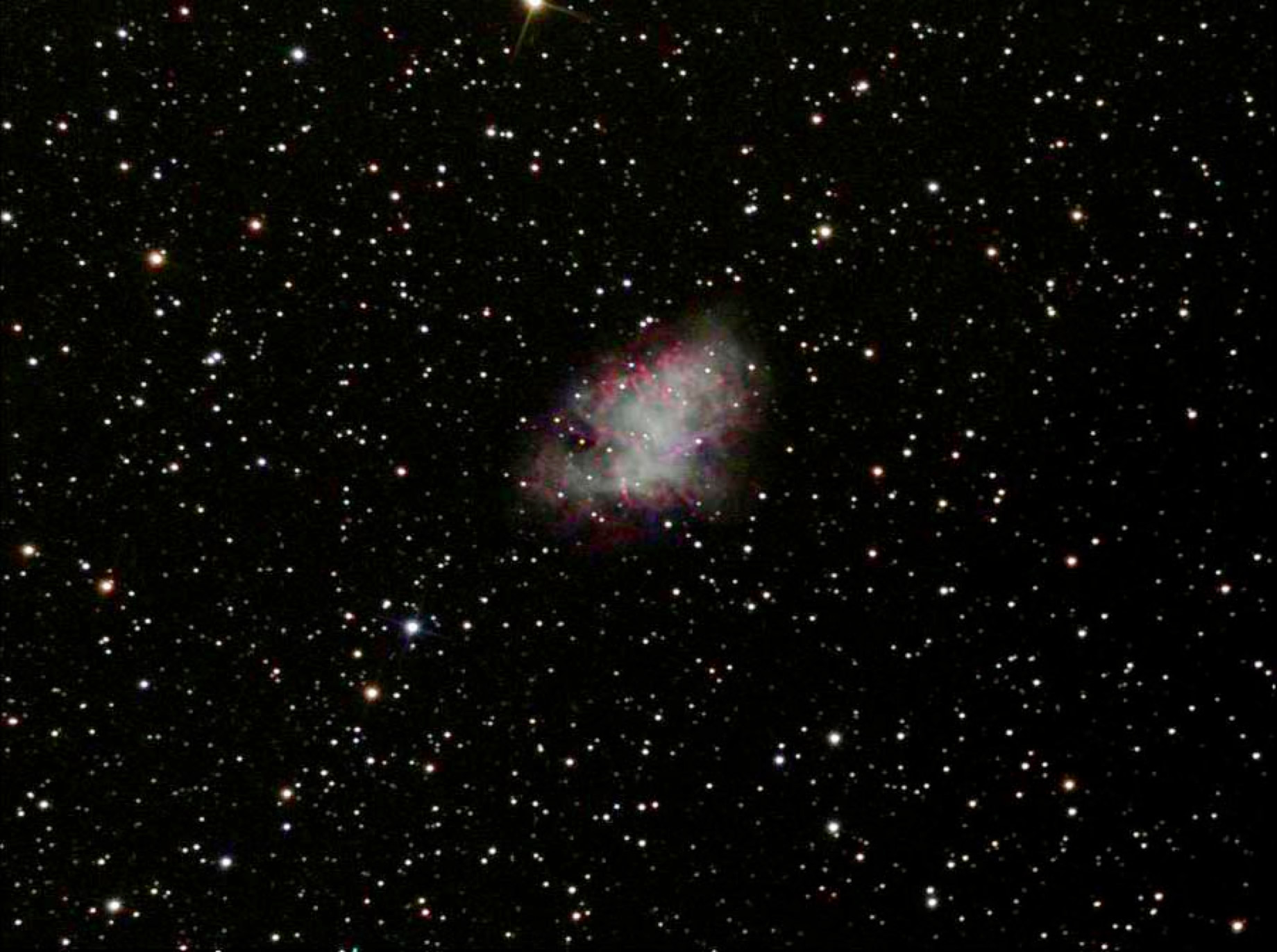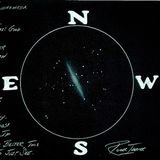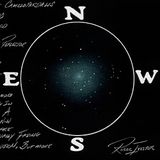
It was in the early morning of September 12th, 1758, when French astronomer and comet hunter Charles Messier, by accident, located a very faint nebula in the constellation of Taurus. This object would later come to be known as the the "Crab Nebula," or Messier 1, the first of over 100 galaxies, nebulae, and star clusters recorded in a catalog to prevent other comet seekers from confusing them as comets.
We kick off 2014's monthly challenge with none other but Messier 1: the Crab Nebula, a supernova remnant from a star that exploded in A.D 1054. It was first observed by both Chinese and Arabic astronomers, and was visible to the naked-eye, even during the daytime, for weeks.
The Crab Nebula can be seen in a small telescope, and my first view came many years ago using a 60mm refractor. In recent times, I've enjoyed observing this object with my son and granddaughter, using her 76 mm (3-inch) Orion FunScope Dobsonian, from Las Vegas. It appeared as a faint elongated gray smudge, however, it was very surprising to be able to see the Crab at all from the severely light-polluted location.
When using my 10-inch reflector, from my moderately light polluted backyard, located in the foothills of western North Carolina, the Crab appears pretty bright, with a brighter more concentrated central region. The NW section is much more broad than the SE, which I call the tail. The nebula is elongated in a NW-SE orientation. On a good night, and using averted vision, it can be fairly easy to see the 'S' shape in the brighter sections, as described by Skiff & Luginbuhl in The Observing Handbook And Catalog Of Deep-Sky Objects. One of the more difficult features is seeing the faint notch on the SE edge which takes a bite out of the nebula. I've seen this only one time on a night of excellent seeing and transparency using the 10-inch.
There's a faint triangle of stars on the NNE edge, and several faint stars touching the nebula on the SSW. I find the best overall magnification for this object is around 100X, and an Orion SkyGlow filter seems to improve the contrast. When using a 14.5-inch reflector, there are several very faint stars which can be seen embedded within the nebula.
The following sketch was made with a No. 2 pencil and a blank 5 x 8 note card, and the colors were inverted using a scanner.

Many have observed all 110 Messier objects, using telescopes as small as three inches, and you can too. If you haven't observed the Messier Catalog, why not let 2014 be your year to see all 110 objects? It has always been my opinion that an observing goal can be a great motivator. I often refer to this as "observing with a purpose."
There's nothing quite so rewarding as having a detailed note, and if possible, a simple pencil sketch of all the deep-sky objects you observe. If you're fortunate enough to see and document the entire list, consider pursuing the Astronomical League Messier Certificate. Just go to the AL website and find out what's required to be eligible to join the thousands of other amateurs who've achieved this feat. Be sure to spend plenty of time with each and every object. With careful observing and patience, you may be surprised at the faint details which will begin to emerge. This should not be a hurried quest, but of one of patient solitude and contemplation. Let it be a fun project and enjoy every object, to the fullest. It just might put you on the path to more difficult objects, maybe even the Herschel's. The more serious you are with your observing, the more likely you'll continue for many years to come. Let your pursuit of the heavens become a lifelong endeavor, and you'll gain much joy and satisfaction as the years pass. The changing constellations will become good friends as the seasons come and go.
Of course, one of the most interesting parts of observing carefully and recording what you see is comparing your notes to others. No two observations are ever exactly the same. Here are a few observation notes about M1 from notable observers in various locations:
Sue French from New York: Although the Crab Nebula is quite challenging for novice observers, it can be spotted as a ghostly little smudge through 7 X 50 binoculars under semi-rural skies. A 130mm refractor at 37x showed an oval nebula that was fainter around the edges and narrower at one end. At 102x, the Crab's interior appeared mottled, and the edges looked frilly. An O-III nebula filter considerably dimmed most of the nebula, but with study, it unveiled vague traces of the filaments that are so prominent in photographs. At 164X, the nebula's interior was strongly patterned, and its edges were faint.
Maria Grusauskas of Orion, from California: Using a 127mm f/7.5 refractor, at very low power (23X), the Crab Nebula was a promising smudge of white in a relatively starless area, with no stars resolved within the nebula that I could see. To the southeast, it was anchored by the bright blue star Zeta, and a hook-shaped asterism of six stars. At higher power (56x), the Crab "body" began to be more apparent, shaped very much like the body of a Dungeness crab, with a star flanking each side of the greatest distance across, to the northeast and southwest. A brighter central region was apparent with averted vision. A week earlier, in an 18-inch telescope, observing M1 resolved definite suggestions of spindly legs and a heightened dimension of nebulosity (with a high contrast multi-band nebula filter).
The Crab was also just barely detectable in 10 X 70 binoculars as a faint smudge, but only with averted vision. Observed on a frosty 32º night at a dark site known as Deep Sky Ranch in Paicines, California.
Kevin Ritschel of Orion, from California: In a 127mm f/7.5 refractor, at (56x), M1 preceded a fairly bright field star to the southeast of the nebula. The nebula, I would say, was of medium brightness, but not uniform in texture. It had a brighter irregular core, and fainter extensions. The nebula was oval shaped. It was somewhat mottled, with hints of filamentary structure, but very subtle. This observation was made with the Crab Nebula near the meridian, and without the use of any filters.
In an Orion StarBlast 62mm telescope at (21x), it appeared as a rather faint smudge, about half the field away from Zeta, as, again, mostly even, but brighter in the central region, with an oval shape.
Using a 12-inch f/8 reflector, on the morning of December 13, 2013, at 149X, the Crab definitely had two components, a smooth 'S' shaped inner core and a slightly less bright outer shell that, while oval, was far more circular than the smooth inner core. At higher power, the Crab filled between 1/2 and 1/3 of the field of view. The outer shell was on the verge of resolving into filaments and would likely have done so with the aid of an O-III or UHC narrowband nebula filters. With a 33-inch f/5 Newtonian, and an O-lll filter, the filaments were obvious, even to inexperienced observers who had never seen them before.
Jaakko Saloranta from Finland: Using an 8-inch Orion DSE Telescope at 300X with a UHC narrowband filter: "Bright, NW-SE elongated diffuse little peanut. Slightly brighter in the middle with several 14th magnitude stars visible in the vicinity."
Fred Rayworth from Nevada: The Crab Nebula usually appeared as a fat 'S' shape, though when seeing was superb, it would fill in as a ragged oval shape. During those moments of superb seeing, I could pick out mild mottling and filaments within the core and along the edges. However, nights of great seeing were rare, so mostly it was just the fat 'S' shape. An O-III narrowband nebula filter made the nebula worse, almost blocking it out, as did the H-beta, which blocked it out completely. Years ago, I tried an LPR filter (SkyGlow) filter and it helped just a tad. The best view, by far, is unfiltered. Magnifications ranged from 70-220x with the best views at 102x. Most observations were made with either a home-built 16-inch f/6.4 reflector or a commercial 16-inch f/4.5.
Jay Thompson from Nevada: Using a 17-inch Newtonian and a magnification of 227x on an exceptionally clear and steady night, in Meadview, Arizona, I was able to discern filaments superimposed on the oblong nebula. The glow from the main body is fascinating since it arises from synchrotron radiation.
The following image was made by Dr. James Dire from Wildwood Pines Observatory in Earl, North Carolina, using an 8-inch f/7 reflector:
Take some time to observe M1 with us. Come back and leave your observation notes in a "Review" of this article, below!
Roger Ivester has enjoyed the wonders of the night sky since he was 12 years old. He is a visual observer and enjoys sketching and writing about what he sees. In 2009 he helped start the Las Vegas Astronomical Society Observers Challenge, and works with fellow club member Fred Rayworth of Nevada on a monthly basis to compile the report. Roger and his wife Debbie live in the foothills of western North Carolina, with their Persian Cat CJ, and their miniature long haired Dachshund, Nova Sophia.
























